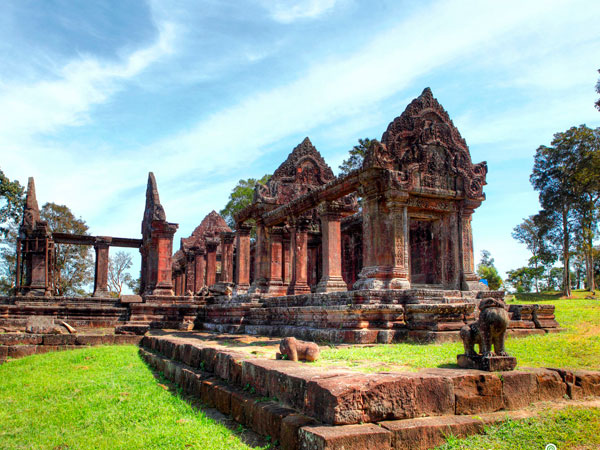Koh Ker was once an ancient capital of Cambodia, located in Srayong Cheung village, Srayong commune, Kulen district, about 49 kilometers west of the provincial town. The Koh Ker complex is on the Chhork Koki highland. It was built by King Jayavaraman IV (AD 928-942). Koh Ker temple is 35 meters high, and its design resembles a seven-stepped stupa. The temple faces west toward Angkor city. It was built to worship Treypuvanesvara, the god of happiness.
So far, 96 temples have been found in Koh Ker: Dav, Rumlum Bey, Beung Veng, Trapiang Prey, Dey Chhnang, Srok Srolao, Lingam, Kuk Srakum, Trapiang Ta, Sophy, Krahom, Andoung, Ang Khna, Teuk Krahom, Damrei Sar, Krarab, Banteay Pichoan, Kuk, Kmao, Thneung, Thorn Balang, Rohal, Chamneh, Sampich, Trapiang Svay, Neang Kmao, Pram, Bat, Khnar Chen, Klum, Chrab, Dangtung, Prang, Kampiang.... These temples were not constructed near each other. Today, many of them are no longer standing, and some are buried in the ground. The followings are locations and descriptions of some of the Koh Ker temples:
Neang Khmao Temple
The Koh Ker complex is along a trail that is about 3 kilometers long. The first temple, Neang Khmao sits atop a small hill on the east side of the trail. The temple, which faces west toward Angkor city, is made of sandstone. It is 20 meters high and resembles a stupa. The temple terrace is 2 meters high and divided into three decks. The temple is surrounded by a laterite rampart, 44 meters square and 2 meters high. The rampart has only two openings; one on the east side, and the other on the west. The temple once housed lingam and yoni, but only yoni remains. The lintel sculpture has been damaged, but otherwise, most of the temple is in good condition, while nearly three-quarters of the rampart is good condition.
Pram Temple
About 700 to 800 meters north of Neang Khmao temple is another temple called Pram temple. Constructed of laterite and sandstone, it sits on a small hill surrounded by bushes that block the lingam and the lintel. The main body of the temple is in good condition.
Chen Temple
Farther down the trail is a three-peak temple made of laterite and sandstone. It faces east and is called Chen temple. Inside the temple there is a piece of lingam and remnants of a statue of King Jayavarman IV. A sculpture of garuda's head on the south lintel is missing. The temple is overgrown by forest.
Preng Well
About 800 to 900 meters farther, there is the Preng well, which is similar to a pond. Surrounded by stone, it is 20 meters square. The terrace is about 8 centimeters high. The water in the pond is clear, and a nearby tree provides shade for weary visitors looking for a place to relax.
Rampart of Koh Ker Temple
Another kilometer down the trail is the rampart of Koh Ker temple. 1 kilometer long and 2 kilometers high, it is made of laterite. Koh Ker temple is the middle of a rampart, surrounded by 20 more temples. Some of the temples are:
Kuk Temple or Gopura
Kuk temple or Gopura is made of sandstone and has a sculpture of lotus petals on the temple fronton. Although the door frame is damaged, most of the temple is in good condition. A Shiva lingam that once was housed inside has been looted.. Prang Temple
Prang temple is constructed of sandstone and bricks. There are five separate parts of this temple. About 70 percent of the temple is still standing.
Krahom Temple
About 10 meters farther is Kramhom temple (The red temple). Constructed of brick and shaped like a seven-level pyramid, the temple is decorated with a 20-meter-tall sculpture of lotus petals. Inside the temple, there is a 3-meter-tall statue of Shiva with eight arms and four heads. The statue is supported by a l-square-meter base. The statue is seriously damaged, only some parts remain.
Khmao Temple
Farther down is Khmao temple. On the wall and door frame of the temple, there is a partially damaged inscription. Near the temple is a rampart gateway to Kampiang temple. The gateway is a 2-meter staircase. Some sculptures of lotus petals, seven-headed nagas and garudas remain.
Koh Ker Temple
About 300 meters farther to the west is Kampiang or Koh Ker temple. From a distance, the temple looks like a small hill, because it is covered by forest. Up close, however, it is actually a 35-meter-high stupa made of sandstone. It has seven levels, each level about 5 meters above the other. Each deck has a 2-meter-wide terrace, and there is a 55- step staircase to the top. At the top of the temple, there are large statues of garudas supporting Shiva lingam Treypuvanesvara. Nearby, there is a 4-meter square well, now completely covered by grass. According to local villagers, if a coconut is dropped into this well, it will appear in the pond near Neang Khmao temple. There is vegetation growing on top of the temple, and from there visitors have an excellent view of the surrounding landscape, in particular, Phnom Dangrek, Phnom Tbeng, and Kulen district.To the north of Koh Ker temple is another temple, Damrei Sar temple, but it is heavily damaged. To the northeast, is Iingam temple. This temple once housed three Shiva lingams, but some are now damaged.







